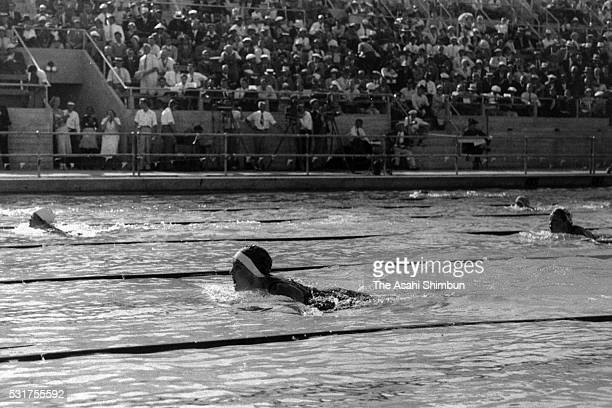United States compete in the Swimming Women’s 200m Breaststroke final during the Los Angeles Summer Olympic Games at the Olympic Park Swimming Stadium on August 9, 1932 in Los Angeles, California. (Photo by The Asahi Shimbun via Getty Images)
” data-medium-file=” data-large-file=” class=”wp-image-86542″ style=”width: 600px” src=” alt=””/>
article by Nicholas Pucci
Se Japan participates in the Games for the first time in Stockholm in 1912with Shizo Kanakuri running the marathon and Yahiko Mishima lining up at the start of the 100, 200 and 400m dash events, eight years later, in Antwerp 1920, he stands on a five-circle podium for the first time, with Ichiya Kumagae wearing two silver medals around his neck in the tennis tournamentin singles losing in the final to South African Louis Raymond and in doubles partnering Seiichiro Kashio. To snatch the first gold medal, then, we have to wait another eight years, when, in Amsterdam 1928, Mikio Oda imposes himself in the triple jump and Yoshiyoki Tsuruta is the best of all in the 200m breaststrokeboth starting the Japanese dominance in the two specialties, later confirmed with the victories of Chuhei Nambu and Tsuruta himself in Los Angeles, in 1932, and of Naoto Tajima and Tetsuo Hamuro in Berlin, in 1936.
In short, athletics and swimming are Olympic disciplines appreciated by the subjects of His Majesty the Emperor, but… but there is something missing, so that Japan can to all intents and purposes compete with the great powers of world sport. Of course, you’ve guessed it, the strength of the female competitive movement given that when the Olympics opened in Berlin 1936, still no Japanese athlete was able to seize a gold medal in the five-circle review.
To tell the truth, ad Amsterdam 1928in the days when boys finally climbed to the top step of the podium, the first girl from the country of the Rising Sun went home with a medal around her neck, in this specific case Kinue Hitomi, good enough to deserve the silver medal in the 800 metersbeaten only by the German Lina Radke, when then four years later, in Los Angeles, Hideko Maehata is also second in the 200m breaststrokeforced to surrender to Australian Clare Dennis.
Here she is, therefore, Hideko Maehata, the protagonist of our today’s story, who was born on May 20, 1914 in Hashimoto, and who already as a young girl learned to swim in the waters of the Kinokawa River. Effectively she is really good, so much to achieve, at the tender age of 10, an unofficial youth record on the 50 meters breaststrokewinning series races and gaining admission to the Sugiyama Girls’ Swimming College, which, after being forced to return home due to the death of her parents, both of whom suffered a stroke in 1931, guarantees her selection for the 1932 Los Angeles Olympics. From which he returns home with a silver medal and the election to star of absolute magnitude of Japanese sport, albeit be criticized by Tokyo mayor Hidejiro Nagata for failing to achieve a victory that would have suited the city that was vying to host the 1940 Games.
However, everything does not go smoothly for the young Hideko, who, due to the loss of her closest loved ones, also hypothesizes the idea of abandoning the competitive activity once the Californian Olympic experience is over, but Hidejiro Nagata himself asks her if by chance is willing to go and get the gold at the 1936 Games, and for Maehata this becomes the goal of the following four years. With the corollary, to make time September 30, 1933, del new world record on the 2o0 breaststroke set at 3’00″4which makes her the underdog at the next Berlin Olympics.
Just to give an idea of the notoriety achieved by Maehata, and how much her exploits in the water are followed at home, suffice it to say that the 200-meter breaststroke event at the 1936 Games is broadcast live on radio in Japanregardless of the time zone. And that Hideko is competitive at the highest level, from August 8 to 11 atOlympic Park Swimming Stadiumis certified by time recorded in heat, 3’01″9, to improve the Olympic record set a few minutes earlier by the 25-year-old German Martha Genenger, 3’02″9, who in the absence of the title holder and as European distance champion for the success obtained in Magdeburg in 1934, it is to be considered the most accredited rival of the Japanese breaststroker.
The two Danes Inge Sorensen, who is just over 12 years old, and Valborg Christensen, as well as the other two darlings of the home crowd, Trude Wollschläger and Johanna”Hanni” Hölzner, the Dutch Jopie Waalberg and Jenny Kastein, and the British Doris Storey, have some good cards to play at the medal table, but also in the semifinal Maehata and Genenger are the fastest of the lot, this time with the Germanic to sign the best time in 3’02″8entering by force as favorites in a final from which Christensen and Wollschläger remain excluded.
August 11, 1936 is a historic date not only for women’s swimming, but for all Japanese skirt sport. Maehata and Genenger swim side by side for at least 150 metres, with the Asian dictating the pace in the water and the German following behind, but when Hideko accelerates in the last tank, the moment has finally come that an entire country awaits with ears glued to the frequencies of NHK Radio. Maehata touches first, 3’03″6, ahead of her rival and the very young Sorensen by six tenthswho at 12 years and 24 days is the youngest winner of an individual medal at the Games, and now yes the “Flag of the Sun in the shape of a disc” can fly as high as never before for a gentlewoman.
